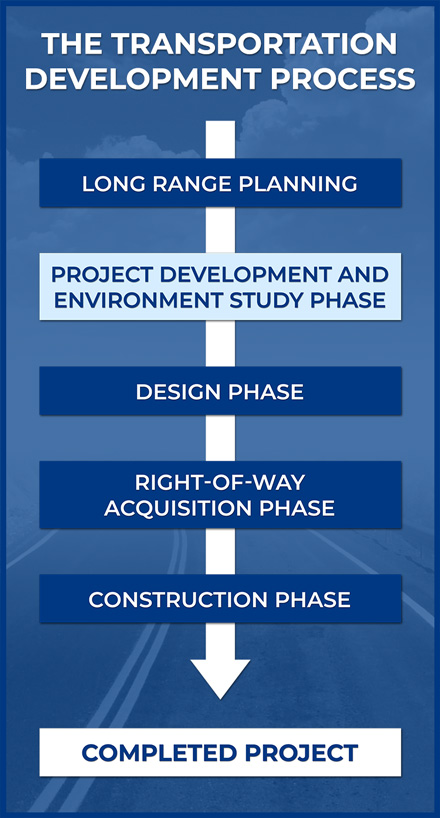A Project Development and Environment (PD&E) Study is a comprehensive study that evaluates social, economic and environmental effects associated with the proposed transportation improvements so that the FDOT can reach a decision on the type, location and conceptual design to meet the project’s proposed purpose and need. The PD&E study is the second phase of the FDOT’s 5-step highway development process, as shown below.
Five Steps in the Transportation Development Process

- Long Range Planning: The FDOT and local governments conduct long-range transportation planning on an ongoing basis to identify and prioritize individual projects.
- Project Development and Environment Study: During this step, design concept options and their social and environmental effects are examined.
- Design: During design, detailed construction plans are prepared.
- Right-Of-Way Acquisition: This phase entails acquisition of any necessary right-of-way, based on the design plans.
- Construction: The roadway is built during this phase.
A PD&E Study is conducted to meet the requirements of the National Environmental Policy Act (NEPA) for projects with federal funding. A Class of Action is assigned for each project based on the level of social, economic and environmental impact, among other factors, anticipated for a project. The federal Class of Actions, in order of magnitude from less to greater impacts, include: Type 1 Categorical Exclusion (CE), Type 2 CE, Environmental Assessment/Finding of No Significant Impact (EA/FONSI) or Environmental Impact Statement (EIS). The Location and Design Concept Approval (LDCA), or final project approval, is signed by the FDOT Office of Environmental Management (OEM).
For projects without federal funds, the study would need to meet state requirements which are similar to federal requirements in analyzing the effects of the proposed improvements on the social, physical and natural environment. The state equivalent documents are called a State Environmental Impact Report (SEIR) or a Non-Major State Action (NMSA), and the document is signed by the FDOT District Secretary/Delegated Authority or designee.
During the PD&E study process, feasible alternatives are developed for roadway improvement projects. These “Build” alternatives are evaluated based on environmental, engineering and socioeconomic conditions, safety needs and public input. The need for additional right-of-way for stormwater, floodplain compensation and environmental mitigation is also evaluated during the PD&E study phase. The “No Build”, or no improvements alternative, is considered to be a viable alternative and will remain so throughout the study. If the study results in a “Build” alternative being selected, the project may proceed to the next phase if funding is available.
These I-75 projects are currently in Step 2 (PD&E study phase). The study team has gathered information on various social and environmental resources in the project study area. These resources included residences, public facilities, and commercial buildings as well as wetlands, streams and floodplains; protected species; archaeological sites and historic structures; and contamination sites near the project corridor. The intent of the PD&E study process is to study each viable alternative to the level of detail necessary to accurately assess any potential impacts associated with the proposed improvements and to make a recommendation of the preferred alternatives. This process is mandated by federal and state laws.
